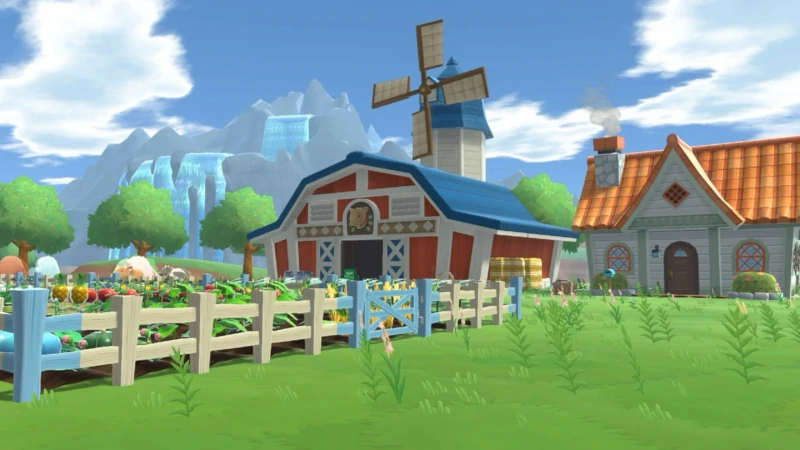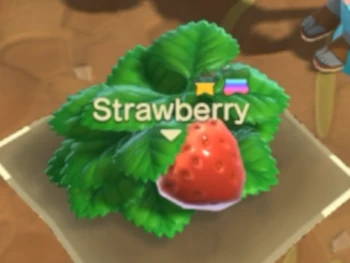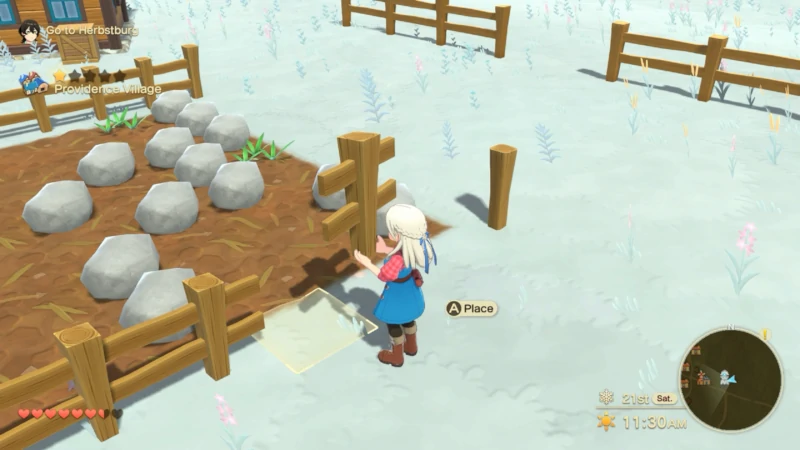Growing Crops and Flowers
Jump to: Finding Seeds | Ability/Star Rank/Health | Mutations | GIANT Crops

There are a variety of farm space to choose from in Anthos. Each space has a fixed-size crop field and location. Some have small fields while others have large field. Crops can be grown in any available farm space, even if the location isn't where your farmhouse is located. You can move your home base to any farm space by interacting with the Expand-o Farm perch at the farm space location. Moving to a new space takes a full-day of game time.
The farm space you choose will have a dominant season or terrain. Farm spaces close to a village will also increase that town's cultural level when goods are shipped via the farm's shipping bin:
 The Breezy Plains Farm, Desert Entrance Farm, Harvest Goddess Farm,
Providence Farm, River of Blessings Farm, and Twins Pond Farm are normal, flatland field spaces
with year-round seasons. Shipping items when your homebase is set to be the
Providence Farm will influence Providence's cultural level.
The Breezy Plains Farm, Desert Entrance Farm, Harvest Goddess Farm,
Providence Farm, River of Blessings Farm, and Twins Pond Farm are normal, flatland field spaces
with year-round seasons. Shipping items when your homebase is set to be the
Providence Farm will influence Providence's cultural level. The Southern Cliff Farm and the Lectenbury Farm where you started the game are spring season
farm spaces. Shipping from the Lectenbury Farm influences Lectenbury's cultural level. The farm space in Lookout Plains that appears with the Visitors from Afar DLC also has a spring environment but influences Verne Village's cultural level.
The Southern Cliff Farm and the Lectenbury Farm where you started the game are spring season
farm spaces. Shipping from the Lectenbury Farm influences Lectenbury's cultural level. The farm space in Lookout Plains that appears with the Visitors from Afar DLC also has a spring environment but influences Verne Village's cultural level. The Lilikala Farm space near Aestes' location is a summer season farm space.
Shipping goods from here influences Lilikala's cultural level.
The Lilikala Farm space near Aestes' location is a summer season farm space.
Shipping goods from here influences Lilikala's cultural level. The Golden Hill Farm and the Herbstburg Farm are autumn season spaces.
The Herbstburg Farm space will influance Herbstburg's cultural level.
The Golden Hill Farm and the Herbstburg Farm are autumn season spaces.
The Herbstburg Farm space will influance Herbstburg's cultural level. The Snowy Playground Farm and the Zimagrad Farm are both winter season
farm fields. The farm in Zimagrad will influence that town's cultural level.
The Snowy Playground Farm and the Zimagrad Farm are both winter season
farm fields. The farm in Zimagrad will influence that town's cultural level. The Oasis Farm just southwest of the desert oasis has year-round seasons
and an arid/desert terrain.
The Oasis Farm just southwest of the desert oasis has year-round seasons
and an arid/desert terrain. The Lava Hot Springs Farm located within the firy mountain has year-round
seasons and a volcano terrain.
The Lava Hot Springs Farm located within the firy mountain has year-round
seasons and a volcano terrain.
The Oasis Farm and the Lava Hot Springs Farm are usable after you complete the game's story.
Obtaining Seeds
Seeds are mainly collected from interacting with the Harvest Wisps found all around Anthos. They can be out in the open or pop up when cutting grass, chopping trees, and smashing rocks.
- Harvest Wisps wearing purple clothing give up to 2 bags of seeds, though usually only 1 bag.
- Harvest Wisps wearing blue clothing are rarer and can give up to 5 bags of seeds.
The blue-suited wisps will run away if you walk close to them too fast. Slowly walk up to a rare wisp by utilizing the Left Shoulder button on your game controller, then collect their seeds when you're close enough.
While riding a mount, you can outrun a fleeing blue seed wisps and collect its seeds before the fairy disappears. The faster your mount (e.g., unicorn or raptor), the easier it is to catch a rare wisp while it's trying to escape.
One bag of seeds will plant one square of field soil. Use the hoe to till the soil in a field, then plant the seed. While an icon on the seed's bag hits at the plant's preferred season or terrain, you can plant any seed in any field during any season.
Besides the little floating guys, plant seeds can be given as rewards for completing villager requests and purchased from shops. Store inventory options will expand as you solve the towns' wall problems. Typically, town shops are limited to selling 3 bags of seeds per crop variety. They may take some time to restock if you buy all they have available. There is a way to get past the limit-3-per-purchase restriction. Buying as much as you want unlocks as you increase a crop's ability.
Harvest Wisps will give more during seasons their seeds prefer. For example, you'll get a few more bags when collecting seeds in the snowy region during winter season, or when getting seeds from Harvest Wisps around Lectenbury during spring, etc.
Ability, Star Rank, and Health

Standing next to a crop will display its name, its star rank (the yellow icon), and its health (the square-ish icon).
Each crop has an ability that determines how easily its star rank increases. You can view your crop abilities in the Encyclopedia section of the DocPad. The crop's ability rank will increase as you harvest that crop:
- 0 to 49 total harvests = Newbie
- 50 to 249 total harvests = Intermediate
- 250 to 499 total harvests = Advanced
- 500 or more total harvests = Master
The higher your ability with that crop, the easier it is to increase the crop's star rank when applying Fertilizer to the plant. You can purchase Fertilizer from tool shops and flower shops for 15 G per bag. It can also be manufactured on your farm by converting 1 Compost (collected from the barn floor using a pitchfork) into 1 Fertilizer at the fertilizer processor next to the field space.
Fertilizer vs. Compost? Both soil amendments can be used on a growing crop to increase the crop's health, but the Fertilizer has a greater influence on increasing crop star rank than using barn Compost.
The higher the star rank of the crop at the time of harvest, the more money it will bring when shipped. Higher-quality crops can also be used for kitchen recipes, with the resulting dish having a higher star rank than if 0-star ingredients were used.
Reaching the Advanced ability with a crop will add a new inventory option at a town shop that allows you to buy as many of that crop's seeds as you want. The limit-3 inventory slot will still be part of the shop's inventory, but scroll down to the bottom of the shop's inventory to find the unlimited option.
The other gauge on a crop is its health. Crops planted in their preferred terrain or season will have better health overall. The healthier a plant is, the greater the chance the crop could mutate at harvest if all other planting conditions are correct for triggering the mutation. Crops with poor health may turn brown and wilt before they die, in which case, a good dosing of Fertilizer and some water should revitalize the plant.
You can greatly influence a crop's health by spreading season/terrain fertilizer on the plant. For example, using Volcano Fertilizer on crops grown in the volcano farm space to increase plant health, which in turn will increase the chance of mutations.
Watering a crop ensures that its health remains good, but there may be instances where you can skip a day of watering and not have a negative impact on a crop's health. The crop will mature as long as it has some health indicated on its health box icon. Doc Jr can craft sprinklers at his workshop in Lectenbury: a 3x3 sprinkler, a 4x4 sprinkler, and a 5x5 sprikler. Place the sprinkler in the field and the device will handle all the watering for you.

Because the weather in Anthos can be turbulent, fencing can be installed around fields to protect the tender plants from storms. Doc Jr sells Wooden Fences, Wooden Fence Corners, and Wooden Fence Entrances that can be installed around a field. During a storm, the protective qualities of the fence will cause the wooden barriers to shine. The weather protection activates when the field perimeter is surrounded by fence. Placing a small area of fence within a field will not protect your plants from bad weather (e.g., making a 10x10 fenced area in a field that's 20x30 in size will not activate fence protection powers.)
Installing a few pieces of fence will offer some protection from milder weather, like rain, but not from a powerful storm. Encircling the whole field is ideal.
There are several colors of fences: brown, white, blue, and pink. All color options offer the same protection for crops. The color options are for you to style the farm as you want, such as mixing a white fence with blue gates.
If you have the crop fields surrounded by fences, even when you aren't using the field at that farm space, the Tiny Harvest Goddess will reward you the day after a storm for proactively installing fences. She'll give you crop seeds and specialty fertilizers depending on where the storm occurred. For example, suppose a storm occurred in the desert, and the Oasis Farm space had a fence around its field. In that case, Tiny will reward you with Desert Fertilizer the next morning even if nothing was planted in the Oasis Farm field. The only thing you need to do is enter the area where the storm is taking place. The more fields that are protected by fences, the greater the reward.
If you don't have bag space to receive Tiny's fencing gifts, the items will fall to the floor around the bed. You can pick the bags up later.
Mutations

Crops with good health have a chance to mutate into a different variety. The crop needs to be planted in the right season or terrain to trigger the genetic change. Discovering mutations is easier in The Winds of Anthos when compared to other versions of the series, as first-generation and second-generation crop seeds can appear as Harvest Wisps.
Triggering mutations can happen when:
- a plant can mutate (not all of them do),
- the plant is grown either the right season or terrain (there isn't a season and terrain requirement in this game), and
- the plant has enough health to have a chance to mutate successfully.
For example, you want to trigger a Blue Herb mutation. To do this, you can plant Celery anywhere during summer, but what if it isn't summer season? Go to Lilikala, where it is summer all year, and plant the Celery there. Blue Herb is a season-based mutation.
Perhaps you want a Giant's Heart needed for the farmhouse storage upgrade. That mutation is specific to growing Heart of the Earth at the Lava Hot Springs Farm in the middle of the volcano, regardless of your current season. Giant's Heart is a terrain-based mutation.
Each plant entry in the DocPad's Crop or Flower Encyclopedia will display a "?" box under the plant's description if a mutation is associated with that plant. The sequential listing of the mutation entries are Spring, Summer, Autumn, Winter, Flatlands, Desert, and Volcano. For example, when looking at the encyclopedia entry for Asparagus and you've unlocked the first mutation, Purple Asparagus (an autumn mutation), and the third mutation, Water Asparagus (a desert mutation), then you can assume that the missing Asparagus mutation is associated with either a winter season or a flatlands terrain, as those are the categories between Autumn and Desert. That will help narrow down where to plant the Asparagus to trigger the missing mutation.
Mutations will happen when the day begins at 6:00 am or when you awaken in the morning, whichever occurs first. When trying to trigger a rare mutation, use the GAME SETTINGS > SAVE option to save your game the night before instead of the SAVE AND SLEEP option that appears when going to bed. You can reload your game to the night before when using regular SAVE, but the SAVE AND SLEEP will reload your game to the morning after any mutations have already been set for the day.
Special Fertilizers
You can use special fertilizers to influence a plant to trigger season/terrain mutations when grown in other fields. These special fertilizers cost 1500 G each and can be purchased from town Flower Shops after the town walls have been destroyed. Nemo also sells these fertilizers while he is in advernturing merchant mode, and sometimes you'll receive them from Tiny as a reward for protecting fields from storm damage.
The special fertilizers can also be made using the fertilizer converter on your farm. You can buy the recipes for Spring Fertilizer, Summer Fertilizer, Fall Fertilizer, Winter Fertilizer, Flatlands Fertilizer, Volcanic Fertilizer, and Desert Fertilizer when Nemo is in adventuring merchant mode. Combine the normal Fertilizer with various flowers to produce a bag of special fertilizer.
Besides changing the mutation conditions of a crop, these special fertilizers also greatly impact the health of crops. I did an experiment in the desert farm space where some crops received Desert Fertilizer and some received none. The crops that received the Desert Fertilizer (and had high health) all mutated, while only a few crops mutated in the group that did not receive any Desert Fertilizer.
After harvesting a multi-harvest crop that has been influenced with special fertilizer, the plant will revert back to the default influences based on where/when it was planted until you spread special fertilizer again. For example, spreading Volcano Fertilizer on a Pineapple grown in a flatlands field during summer can result in Energy Pineapple at harvest (Energy Pineapple is a terrain mutation). If you don't apply Volcano Fertilizer when the plant is generating its next harvest, you'll get Peach Pineapple instead (the summer mutation of Pineapple).
Giant Crops

At the bottom of the Crop Encyclopedia are 19 entries reserved for the giant crop varieites. These are supersized versions of first-generation crops: Turnip, Asparagus, Broccoli, Cabbage, Celery, Corn, Carrot, Eggplant, Green Bell Pepper, Lettuce, Onion, Pumpkin, Pineapple, Spinach, Wheat, Watermelon, Potato, Strawberry, and Tomato.
Supersizing a usual crop into a giant crop requires the crop to be at maximum star rank at the time of crop maturity. Basically, you need to:
- plant the first-gen crop seed in its preferred season: The plant wants to grow in its happy place to become big and juicy. Look at the seed to see when/where it likes, then plant accordingly. You're not looking to trigger a new variety mutation; you want to enhance the normal crop's growing environment.
- ensure that there is empty field space surrounding the normal crop: When the giant crop growth occurs, the plant will expand its normal 1 square by 1 square size into a 3x3 size. It can't do this if there are other plants in the way.
- spread fertilizer on the plant: You want to increase the star rank of the seed to its maximum level before the plant matures. You do not have to use the special fertilziers to trigger a giant crop (as I initially thought), unless you're trying to trigger a giant crop in a field that doesn't meet the plant's preferred season, such as using Spring Fertilizer on a turnip seed when grown during summertime in a flatlands field, which then forces the turnip to grow as though it was springtime.
Having a high crop ability will maximize the affect of fertilizer applied to the plant. I've had success with triggering a Giant Pineapple with just having the Advanced ability rank with that crop. However, from my experience, quick-maturing crops (carrot, turnip, etc.) tend to grow too fast for fertilizer to maximize star rank when only having an Advanced crop ability. That's not to say that it won't happen; you could get lucky and trigger a fast crop's giant size without much effort. If you are having difficulty getting those star values to fill before plant maturity, work on increasing your ability with that crop to Master to trigger a giant variety.
You can also take advantage of the Harvest Moon that takes place every 8th and 22nd of a season. This special night will influence all planted seeds, resulting in a boosted star rank the next morning. The full moon's powers will help crops reach maximum star rank, which is great for plants that you may only have an Advanced ability with.
The seasons for triggering giant crops that I've found so far are:
- Spring terrain: Asparagus, Broccoli, Carrot, Potato, Spinach Strawberry, Turnip, Wheat
- Summer terrain: Asparagus, Broccoli, Carrot, Corn, Green Bell Pepper, Pineapple, Potato, Tomato
- Autumn terrain: Asparagus, Broccoli, Cabbage, Potato, Pumpkin, Spinach
- Winter terrain: Broccoli, Carrot, Potato
- Desert terrain: Broccoli
- Volcano terrain: Broccoli
Some crops will go GIANT in multiple environments. There may be more terrains that can trigger a GIANT mutation, as I didn't test all of them.
A giant crop will sell for 10x the price of its normal variety. Asking the Harvest Goddess to convert the giant crop into seeds will result in a bag of normal crop seeds.
The Crops, Fish, and Recipes DLC will add Soybean as a crop that can become GIANT sized.